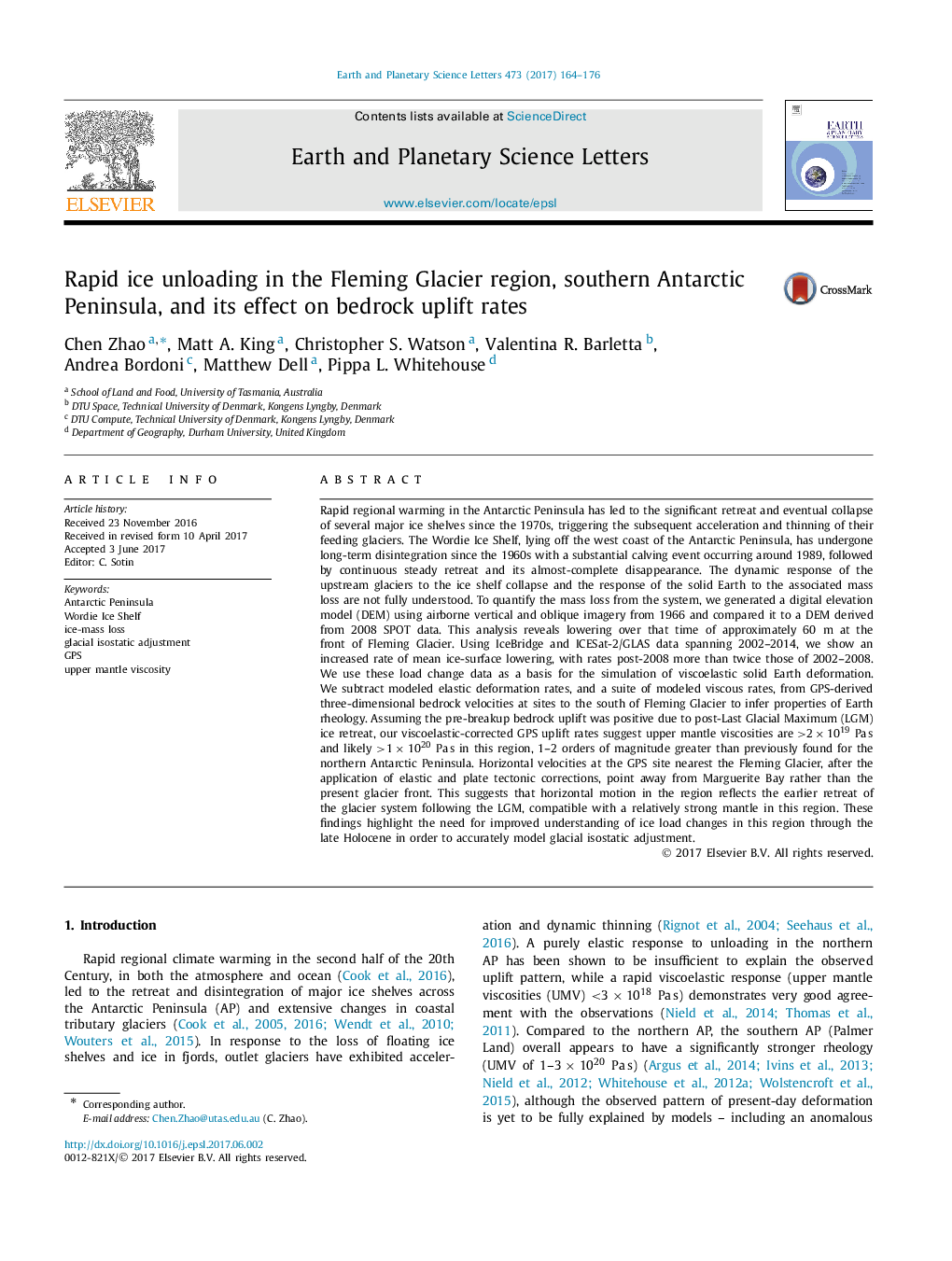| کد مقاله | کد نشریه | سال انتشار | مقاله انگلیسی | نسخه تمام متن |
|---|---|---|---|---|
| 5779695 | 1634683 | 2017 | 13 صفحه PDF | دانلود رایگان |

- Quantification of surface lowering of Fleming Glacier, Antarctica, over 5 decades.
- Surface lowering of >60 m occurred over 1966-2008 at the glacier front.
- Lowering rates over 2008-2015 are up to 4 times greater than that over 1966-2008.
- We compare 3D GPS observations and viscoelastic models to constrain Earth rheology.
- Findings suggest upper mantle viscosity >2Ã1019Pas in this region.
Rapid regional warming in the Antarctic Peninsula has led to the significant retreat and eventual collapse of several major ice shelves since the 1970s, triggering the subsequent acceleration and thinning of their feeding glaciers. The Wordie Ice Shelf, lying off the west coast of the Antarctic Peninsula, has undergone long-term disintegration since the 1960s with a substantial calving event occurring around 1989, followed by continuous steady retreat and its almost-complete disappearance. The dynamic response of the upstream glaciers to the ice shelf collapse and the response of the solid Earth to the associated mass loss are not fully understood. To quantify the mass loss from the system, we generated a digital elevation model (DEM) using airborne vertical and oblique imagery from 1966 and compared it to a DEM derived from 2008 SPOT data. This analysis reveals lowering over that time of approximately 60 m at the front of Fleming Glacier. Using IceBridge and ICESat-2/GLAS data spanning 2002-2014, we show an increased rate of mean ice-surface lowering, with rates post-2008 more than twice those of 2002-2008. We use these load change data as a basis for the simulation of viscoelastic solid Earth deformation. We subtract modeled elastic deformation rates, and a suite of modeled viscous rates, from GPS-derived three-dimensional bedrock velocities at sites to the south of Fleming Glacier to infer properties of Earth rheology. Assuming the pre-breakup bedrock uplift was positive due to post-Last Glacial Maximum (LGM) ice retreat, our viscoelastic-corrected GPS uplift rates suggest upper mantle viscosities are >2Ã1019Pas and likely >1Ã1020Pas in this region, 1-2 orders of magnitude greater than previously found for the northern Antarctic Peninsula. Horizontal velocities at the GPS site nearest the Fleming Glacier, after the application of elastic and plate tectonic corrections, point away from Marguerite Bay rather than the present glacier front. This suggests that horizontal motion in the region reflects the earlier retreat of the glacier system following the LGM, compatible with a relatively strong mantle in this region. These findings highlight the need for improved understanding of ice load changes in this region through the late Holocene in order to accurately model glacial isostatic adjustment.
The distribution of elevation change rates of the feeding glaciers of the Wordie Ice Shelf during a) 2002-2008 and b) 2008-2015 (colors) as derived from a hypsometric model based on the altimetry dh/dt (colored circles).186
Journal: Earth and Planetary Science Letters - Volume 473, 1 September 2017, Pages 164-176